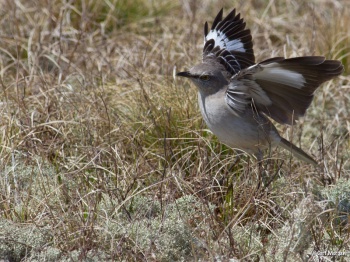(Picture of wing-flashing, References updated.) |
(Similar Species) |
||
| Line 7: | Line 7: | ||
*Slim white eye-line<br /> | *Slim white eye-line<br /> | ||
====Similar Species==== | ====Similar Species==== | ||
| − | May be confused with a Shrike (Northern or Loggerhead), but note different body shape, bill shape, and mask. | + | May be confused with a Shrike ([[Northern Shrike|Northern]] or [[Loggerhead Shrike|Loggerhead]]), but note different body shape, bill shape, and mask. [[Bahama Mockingbird]] is occasionally seen in Florida, and in Mexico there are other species of Mockingbirds. |
==Distribution== | ==Distribution== | ||
Revision as of 16:11, 11 August 2013
- Mimus polyglottos
Identification
- Gray above, white below
- Black flight feathers with large white patches that flash in flight
- White outer tail feathers
- Slim white eye-line
Similar Species
May be confused with a Shrike (Northern or Loggerhead), but note different body shape, bill shape, and mask. Bahama Mockingbird is occasionally seen in Florida, and in Mexico there are other species of Mockingbirds.
Distribution
Breeds commonly throughout most of the USA but absent from the north-west and north-central states, also breeds sparsely in south-east Canada.
Interior populations are migratory wintering in the southern USA, on the east coast resident from Maine southwards.
Casual vagrant north of range.
Introduced to Hawaii.
In the Western Palearctic recorded in Britain, in Cornwall, August 1982 and Essex, May 1988, and at Schiermonnikoog in the Netherlands in October 1988 and another in the Netherlands in March 2001. These birds may have had a captive origin and others seen in Europe are generally considered to relate to escapes including one or two further British reports.
Taxonomy
Subspecies
This is a polytypic species consisting of three subspecies[1]:
- M. p. leucopterus:
- South-western Canada to southern Baja California and south-western Mexico (Oaxaca)
- M. p. polyglottos:
- M. p. orpheus:
Habitat
Woodland edges, copses and hedgerows, very common in suburban gardens and also found in many city parks.
In winter, maintains a small territory around patches of fruiting shrubs/trees that it defends from other birds.
Behaviour
As an intelligent and resourceful bird that is at home in a variety of habitats and can coexist with human settlement, this species is not likely to be endangered in any forseeable future.
They have a habit of wing-flashing, which hasn't been entirely explained.[2]
Diet
These birds forage on the ground or in vegetation and fly down from a perch to capture food. Diet includes insects, berries and seeds.
Breeding
They build a twig nest in a dense shrub or tree.
It agressively defends its nest and territories from all encroachement, and will attack much larger animals and even humans who come too near.
Vocalisation
This species name is a result of its many and varied vocalizations, and its ability to mimic other bird calls and sounds of many types. Particularly at dawn it produces a veritable concert of songs, often not repeating the same pattern for a considerable period.
This habit of singing longest and loudest at dawn leads some people to resent the Mockingbird, and even attempt to eliminate it from their environments.
References
- Clements, JF. 2011. The Clements Checklist of Birds of the World. 6th ed., with updates to August 2011. Ithaca: Cornell Univ. Press. ISBN 978-0801445019. Spreadsheet available at http://www.birds.cornell.edu/clementschecklist/downloadable-clements-checklist
- BF thread discussing wing-flashing behaviour
Recommended Citation
- BirdForum Opus contributors. (2025) Northern Mockingbird. In: BirdForum, the forum for wild birds and birding. Retrieved 19 April 2025 from https://www.birdforum.net/opus/Northern_Mockingbird





